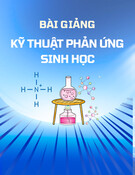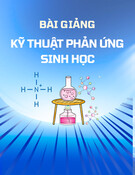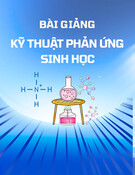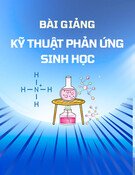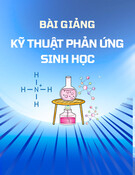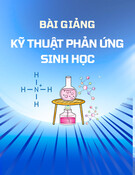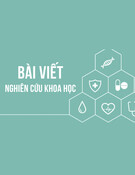
128
HNUE JOURNAL OF SCIENCE
Natural Sciences 2024, Volume 69, Issue 3, pp. 128-137
This paper is available online at http://hnuejs.edu.vn/ns
DOI: 10.18173/2354-1059.2024-0042
EFFECT OF VARIOUS FOOD ON THE GROWTH OF Gryllus bimaculatus De Geer,
1773 AND PROPOSAL OF A BREEDING PROCESS
Bui Minh Hong* and Ta Thi Ngan
Faculty of Biology, Hanoi National University of Education, Hanoi city, Vietnam
*Corresponding author: Bui Minh Hong, e-mail: hongbm@hnue.edu.vn
Received October 4, 2024. Revised October 24, 2024. Accepted October 31, 2024.
Abstract. Biological characteristics including growth and reproduction of crickets
(Gryllus bimaculatus De Geer, 1773) bred on three types of food: 100% vegetables,
100% grass, and 100% synthetic feed under laboratory conditions (25°C temperature
and 75% humidity) has been determined. Crickets' largest reproductive phase size
was observed with those reared on synthetic feed and the smallest on grass. When
raised on synthetic feed, the crickets had a life cycle of around 96.5 days with the
egg phase lasting 9.49 ± 0.40 days, while the nymph phase of 42.08 ± 3.57 days
consisting of 8 stages and the adult phase with a completion time of 48.86 ± 2.94 days.
As for those reared on grass, the egg phase has a completion time of 9.79 ± 0.35
days, whereas the nymph phase prolonged 46.52 ± 2.12 days for 8 stages the adult
phase of 52±2.24 days within the life cycle of 108.5 days. When crickets breed on
grass feed, their life cycle is longer than when they breed on synthetic feed. As a
result, a process for breeding crickets (Gryllus bimaculatus) in the laboratory with
three types of food has been established.
Keywords: Gryllus bimaculatus De Geer, 1773, morphological, biological
characteristics, breeding process, food.
1. Introduction
The Orthoptera has up to 20,000 species including well-known representatives such
as grasshoppers, crickets, and mole crickets. The Gryllidae family belongs to the
Othoptera order and is used as food and medicine. Cricket meat is rich in protein and
contains many essential minerals. In 100g of dried crickets, there are 26.2 mg of albumin,
4.7 mg of fiber, 0.03 mg of vitamin B1, 1.04 mg of vitamin B2, 7.5 mg of various sugars,
120 mg of calcium, 30.7 mg of iron, 26.71 mg of zinc [1].
In Vietnam, the demand for dishes made from crickets in restaurants has increased
significantly. Cricket farming has just been developed in Vietnam for about 10 years and
brings high profits since they are easy to raise and especially the initial investment cost is
low. Recently, the government has had a number of preferential policies for insect

Effect of various food on the growth of Gryllus bimaculatus De Geer, 1773 and proposal of…
129
farming, because of its sustainability and high economic benefits. In Vietnam, cricket
farming has developed strongly in the southern provinces like Ho Chi Minh city and Da
Nang city. In addition to being used to make delicious dishes, crickets can be used as food
for ornamental birds, fish, or baits for fishing. Not only as food, crickets are also utilized
in medicine, entertainment, and cultural beliefs [2].
According to Tu VD and Nguyen VH (2008) crickets (Gryllus bimaculatus) raised
in greenhouse conditions showed a life cycle average of 64.3 days including the egg
incubation of 9.8 days, the larval stage with eight instars of 42.3 days, and the adult
longevity of 35.8 days for male and 28.7 days for female. The mated female started to lay
eggs 13.2 days after the adult emergence and the average number of eggs was 836 with a
hatchability of 92.1% [3]. The research of Dinh TPA and Phan TTH (2013) on the
nutritional characteristics of coal cricket populations at the larval stage in farming
conditions at SonTra District, Danang City, indicated that the food ingredients of crickets
included 14 types of green and 3 types of concentrate. The demand for average food
volume increased rapidly during the larval stage of ages 4 - 8. The correlation between
the demand for the consumption of food and with temperature environment was
negatively correlated [2]. Ngo VT et al. (2021) have raised crickets (Gryllus bimaculatus)
on 9 types of food and reported that food had a great influence on the reproductive and
development ability of crickets under farming conditions in Kien Giang [4].
Currently, cricket farming is becoming more and more popular since it brings high
economic efficiency to farmers. Crickets can be raised in a small area, are easy to care
for, have a short harvest time, and have no pollution problem. This paper provides insight
into the effects of three types of food on the growth and development of crickets (Gryllus
bimaculatus) and proposes the rearing process of crickets.
2. Content
2.1. Materials and methods
2.1.1. Food for crickets
To study the nutritional characteristics of crickets reared under laboratory conditions,
three types of food are used as follows: 100% grass (Cynodon dactylon); 100% vegetables
composed of cabbage (Brassica oleracea), pumpkin (Cucurbita moschata); 100%
synthetic food.
A total of 50g of food was applied for each box per day. Depending on the age of
the crickets, the amount of food is increased gradually as the crickets grow larger.
2.1.2. Rearing equipment
Crickets were raised in transparent plastic boxes of 185×122×128 mm, with
surrounding perforations to provide adequate ventilation. Inside the box, a plastic tray
with a diameter of 5 cm was arranged for feeding, a plastic container of 2 cm in diameter
for water drinking, and a coconut coir for crickets to have hiding spaces and climbing
areas. Handheld magnifying glasses and a micrometer (panme ruler) are used to measure
the size of crickets.

Bui MH* & Ta TN
130
2.1.3. Breeding process
For each type of food, 30 pairs of mature male and female individuals were raised in
30 insect rearing boxes. Depending on the type of food, different feeding trays were
arranged. Food and water were replaced once a day, and the rearing container was cleaned
thoroughly. When transferring crickets for cleaning the rearing container, suitable tools
such as nylon bags, plastic boxes with a diameter of 10 cm, clamps, cloth covers, and nets
were used.
2.1.4. Examination of cricket growth (G. bimaculatus De Geer, 1773)
The growth characteristics of crickets including duration of hatching from egg to
nymph were examined.
All trays of food were placed inside the rearing container for crickets in the evening
of the previous day and removed the next morning. The time for eggs to hatch into nymph
was calculated from the moment the egg trays were removed until the first cricket nymph
appeared. The egg-laying trays had dimensions of 10 cm, with coconut coir used as a
substrate for cricket egg-laying. During the incubation, misting is performed to keep the
egg-laying trays moist. The humidity of the egg trays was checked daily, and misting was
done twice a day. When misting, if the color of the substrate turns darker, it indicates
sufficient moisture. Excessive misting may cause damage to the eggs.
2.1.5. Determination of the life cycle of Gryllus bimaculatus De Geer, 1773
To determine crickets’ life cycle, 30 pairs of mature males and females were raised
in 30 insect breeding boxes containing respective types of food. After a time, a total of
30 eggs were selected on the same day and placed into separate breeding boxes with
different types of food. Then, the time of each phase was recorded.
Egg phase: it is the duration from egg laying to hatching.
Nymph phase: it is the duration from egg hatching to nymph. The first instar stage
was observed from the time the egg hatched until the first instar nymph molted. The
subsequent instar stage was recorded from the time the previous instar nymph molted
until the subsequent instar nymph molted. The third instar nymph is the time from when
the 2nd instar nymph molt until the 3rd instar nymph molt. The fourth instar nymph is the
time from when the 3rd instar nymph molt until the 4th instar nymph molt. The fifth instar
nymph is the time from when the 4th instar nymph molt until the 5th instar nymph molt.
The sixth instar nymph is the time from when the 5th instar nymph molt until the 6th
instar nymph molt. The seventh instar nymph is the time from when the 6th instar nymph
molt until the 7th instar nymph molt. The eighth instar nymph is the time from when the
7th instar nymph molt until the 8th instar nymph molts into adults.
Adult phase: it is the duration from molting into the adult stage until pairing and
laying the first egg.
Data is statistically processed using Microsoft Excel and SPSS software version 20.0
including one-way ANOVA.

Effect of various food on the growth of Gryllus bimaculatus De Geer, 1773 and proposal of…
131
2.2. Research results
2.2.1.The sizes of crickets (G. bimaculatus De Geer, 1773) at the reproductive phases
Food and temperature are important factors affecting the growth and development of
crickets when reared in the laboratory. Previous studies have also shown that diets rich in
organic matter increase the longevity, reproductive capacity, and size of crickets.
Therefore, we conducted a study on the impact of different diets on the growth and
development of crickets. The cricket rearing experiments were conducted in the animal
biology laboratory under conditions of 25°C temperature and 75% humidity. The results on the
size of eggs, nymphs at different ages, and adults are presented in Tables 1, 2, and 3, respectively.
With 100% types of grass and reared at 25 °C with 75% humidity, the lengths, and
widths of crickets at the reproductive phases (eggs, nymph, and adults) varied as shown
in Table 1. The average length of eggs was 1.93 ± 0.33 mm, and their average width was
0.88 ± 0.21 mm. The first instar had an average length of 2.72 ± 0.21 mm and an average
width of 1.06 ± 0.14 mm. The average size of the second, and third instar was 3.66 ± 0.33
mm in length and 1.42 ± 0.12 mm in width. The other instars’ sizes were 4.85 ± 0.39 mm
1.68 ± 0.21 mm, 6.71 ± 0.22 mm 2.82 ± 0.10 mm, 8.52 ± 0.44 mm 3.42 ± 0.15 mm,
11.07 ± 0.99 mm 4.38 ± 0.20 mm and 11.88 ± 1.03 mm 4.45 ± 0.12 mm, respectively.
The eighth instar’s average size reached 19.96 ± 1.21 mm in length and 6.55 ± 0.32 mm
in width.
There was a clear difference in the size of adult males and females, with the average
length of adult females being 26.12 ± 1,08 mm, greater than that of adult males, which
was 25.52 ± 1.52 mm. The average width of adult females was 8.94 ± 0.50 mm, more
than that of adult males, which was 8.33± 0.57 mm.
Table 1. Size of G. bimaculatus reared on grass at different reproductive phases
Phase
Length (mm)
Width (mm)
Min
Max
Medium
Min
Max
Medium
Egg
1.4
3.0
1.93 ± 0.33
0.7
1.0
0.88 ± 0.21
Nymph
First instar
2.5
3.1
2.72 ± 0.21
0.8
1.3
1.06 ± 0.14
Second instar
3.2
4.1
3.66 ± 0.33
1.0
1.7
1.42 ± 0.12
Third instar
4.2
5.5
4.85 ± 0.39
1.4
2.1
1.68 ± 0.21
Fourth instar
6.4
7.0
6.71 ± 0.22
2.6
3.0
2.82 ± 0.10
Fifth instar
7.6
9.1
8.52 ± 0.44
3.0
3.9
3.42 ± 0.15
Sixth instar
9.0
12.6
11.07 ± 0.99
3.9
4.8
4.38 ± 0.20
Seventh instar
10.9
16.4
11.88 ± 1.03
4.2
5.0
4.45 ± 0.12
Eighth instar
17
22
19.96 ± 1.21
6.1
7.0
6.55 ± 0.32
Adult
Female
25
29
26.12 ± 1.08
8.0
10
8.94 ± 0.50
Male
25
28
25.52 ± 1.52
7.0
10
8.33± 0.57
The total number of individuals measured n = 30

Bui MH* & Ta TN
132
The size of crickets bred on 100% vegetable (cabbage, pumpkin) at different
reproductive phases are presented in Table 2.
Table 2. Size of G. bimaculatus reared on vegetables at different reproductive phases
Phase
Length (mm)
Width (mm)
Min
Max
Medium
Min
Max
Medium
Egg
1.4
3.1
1.95 ± 0.30
0.7
1.1
0.92 ± 0.20
Nymph
First instar
2.6
3.2
2.80 ± 0.20
1.0
1.5
1.18 ± 0.15
Second instar
3.4
4.3
3.75 ± 0.21
1.6
1.9
1.68 ± 0.12
Third instar
4.5
6.4
5.18 ± 0.35
2.1
2.8
2.36 ± 0.20
Fourth instar
6.5
7.8
7.15 ± 0.32
3.0
3.4
3.22 ± 0.14
Fifth instar
8.0
9.6
8.92 ± 0.52
3.5
4.4
3.72 ± 0.20
Sixth instar
10
14
12.14 ± 0.68
4.4
5.8
5.40 ± 0.18
Seventh instar
14.5
17.2
15.05 ± 1.02
6.0
6.5
6,31 ± 0.12
Eighth instar
18
25
20.05 ± 1.16
6.7
7.6
7.46 ± 0.20
Adult
Female
25
31
27.06 ± 1.05
8.0
11
9.45 ± 0.30
Male
25
30
26.25 ± 1.32
8.0
10
9.05 ± 0.22
The total number of individuals measured n = 30
For the cricket fed on vegetables, the eggs had an average length of 1.95 ± 0.30 mm
and an average width of 0.92 ± 0.20 mm while the first instar’s average size increased to
2.80 ± 0.20 mm in length and 1.18 ± 0.15 mm in width; the second instar had an average
length of 3.75 ± 0.21 mm and an average width of 1.68 ± 0.12 mm; the third instar had
an average length of 5.18 ± 0.35 mm and an average width of 2.36 ± 0.20 mm; Fourth
instar had an average length of 7.15 ± 0.32 mm and an average width of 3.20 ± 0.10 mm;
Fifth instar had an average length of 8.92 ± 0.52 mm and an average width of 3.72 ± 0.20 mm;
Sixth instar had an average length of 12,14 ± 0.68 mm and an average width of 5.40 ± 0.18 mm;
Seventh instar had an average length of 15.05 ± 1,02 mm and an average width 6.31 ± 0.12 mm;
When it grew to the eighth instar stage, the average size elevated approximately 7 times
with an average length of 20.05 ± 1.16 mm and an average width of 7,46 ± 0.20 mm.
There was a clear difference in the size of adult males and females, with the average
length of adult females being 27.06 ± 1.05 mm, larger than that of adult males, which was
26.25 ± 1.32 mm. The average width of adult females was 9.45 ± 0.30 mm, larger than that
of adult males, which was 9.05 ± 0.22 mm.
With 100% synthetic feed and reared at 25°C and 75% humidity, the length and width
dimensions of the reproductive phases (eggs, nymph, adults) of crickets varied. The
results are presented in Table 3.





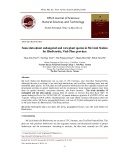
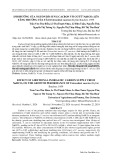
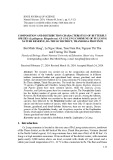
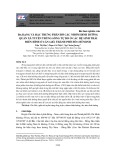
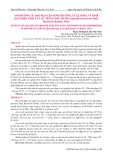
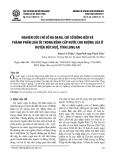

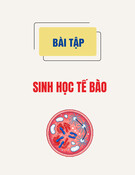

![Bài tập Đa dạng thế giới sống [kèm đáp án/ hướng dẫn giải]](https://cdn.tailieu.vn/images/document/thumbnail/2025/20251123/thaohoang9203@gmail.com/135x160/5861763951302.jpg)
